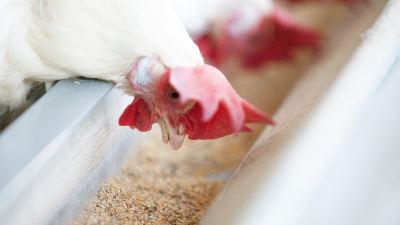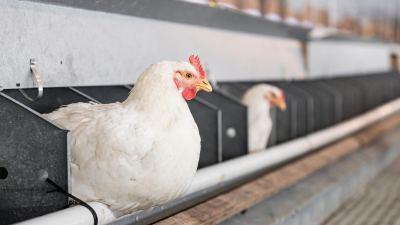Dr. Karina Horgan: Chickens by design

Gene-editing technology like CRISPR enables the development of healthier, disease-resistant birds.
The following is an edited transcript of Tom Martin’s interview with Dr. Karina Horgan, associate research director for Alltech Life Sciences in Dunboyne, Ireland.
Tom: Editing genes to produce designer chickens. We’re talking about it with Dr. Karina Horgan, head of Alltech Life Sciences research in Europe, based in Dunboyne, Ireland. Thank you for being with us.
Karina: It’s a pleasure to be here.
Tom: Dr. Horgan, we’re going to be talking about CRISPR chicken. And to be clear for our listeners, not “crispy” chicken, but the new technology that enables us to create better chickens genetically. Give us some background on this gene-editing technology that’s making a mark in agriculture and poultry, in particular.
Karina: To begin with, we in molecular biology seem to like our acronyms. CRISPR means “clustered regular interspaced short palindromic repeats.” That doesn’t really make it any clearer for anybody, but this technology was discovered initially in bacteria. When viruses invaded bacteria, scientists took some of the DNA that the viruses shot into the bacterial cells, incorporated it into their genome in these short repeat sequences and then they store it as a memory. So, when the same virus attacks the bacteria again, they had to produce what they call guide RNAs, which directed a protein that cuts DNA to the invading viral DNA and just literally chopped it up.
I think in 2013, scientists began to use this in mammalian cells to edit genomes and create mutations within cells. It’s only been recently — I think last year (2016) — that the first publication of using CRISPR in poultry was actually published by a group in Japan.
Tom: Would you say the implications of this technology for agriculture are profound?
Karina: Absolutely, but it has its challenges as well, and people’s perception of genetically modified organisms or plants hasn’t been very good in the past. It’s on us, the ag scientists, to create more awareness of what we’re doing. In some jurisdictions, the perception of GMs or GMOs is that they’re only considered GMOs if you’re taking DNA from one species and putting it into a different species. Whereas if you’re creating a mutation within a species or taking DNA from that species into the same species, they’re not considered GMs or GMOs. In fact, the USDA has recently approved the use of CRISPR — they don’t consider it to be a GMO in non-browning mushrooms.
Tom: What changes are brought about by these genetic modifications?
Karina: They can vary vastly. You can create just a single mutation to stop a gene being expressed. I think this is probably significant for the beef industry in that they’ll be able to change the expression level of a particular gene that stops increases in muscle mass. The other area — which I think is fascinating in terms of safer food and reducing infection in animals — you’ll be able to introduce a CRISPR system into poultry so that, for example with the bird flu virus, this CRISPR complex will be able to recognize the DNA from this virus and destroy it before it infects the bird. So, if you think in terms of the impact that bird flu is having on the poultry industry, to be able to deal with that almost straightaway will have a huge effect in terms of profitability for poultry producers.
Tom: Of course, there’s a great deal of concern these days about antibiotics. Does it have an implication there?
Karina: It potentially does in that if you have a bird that’s more resistant to disease, particularly salmonella or an E. coli infection, you won’t need to use antibiotics to treat those types of diseases. So, yes, definitely it would.
Tom: What would be the benefits to producers?
Karina: To producers, you would have healthier birds that wouldn’t be susceptible to disease.
The other area that I find fascinating in this is the concept of using hens as bioreactors. Hens produce something like 300 eggs per year. I think there are 4 grams of egg white in every egg. Because there are so few proteins in the egg white, it’s easy to purify genetically modified protein in there. So, if you think in terms of the costs of some of the immunotherapies that people need at the moment, if you can get a hen to produce potentially 300 grams of this every year, the cost savings for humans and the medical industry is quite dramatic.
Tom: Taking this from the coop to the kitchen table, what are the implications for human consumption?
Karina: Potentially, you’re looking at less fatty, healthier meat. Reducing issues with food safety in terms of the impact of Salmonella or Campylobacter. So, there’s less risk of food poisoning for people.
If you’re able to produce a bird with less input — less water, less feed — you potentially have 10 percent more meat protein for people. Jack Bobo spoke about 9 million people dying annually from starvation. So, by increasing production or increasing chicken protein by 10 percent, that means 900,000 people who, potentially, wouldn’t starve.
Tom: A reduction in the waste of water is also critical, right? How has this CRISPR technology impacted the field of biology?
Karina: In terms of publication and the amount of funding that is going into CRISPR technology, it has risen dramatically in the last 12 to 24 months. What I see as exciting is that currently a lot of the animal models used to test drugs are mice-based. Mice are genetically quite different from humans. If you could create a model animal that was more similar to humans, where you could test new drug developments on diseases like Alzheimer’s, models that were more humanized, the success rate for development of new drugs should increase. At the moment, I don’t think there is any successful treatment for Alzheimer’s disease on the market, so these types of technologies and development of better disease models would help drug manufacturers to develop a more successful drug more quickly.
Tom: Fascinating. What kinds of market disruptions can we anticipate?
Karina: Another area I think is fascinating is the treatment of malaria and HIV. The hope with this technology is that you’d be able to alter immune cells so they wouldn’t be infected by HIV virus. If you think about the number of people who are killed every year by malaria, could we engineer a mosquito that doesn’t produce malaria or that doesn’t infect people with malaria? And in terms of illness of people in a population, that will be quite a shift in terms of how an insect, mosquitoes as one example, would affect that whole population.
Tom: Those are some incredibly important diseases. What is the likelihood of reaching that level?
Karina: I think it’s very, very likely. From the reading and research I’ve done, the most difficult of the animals to engineer were actually the avian genome. A lot of the work has been done with insects in the past, and Drosophila, the fruit fly, would have been one of the model organisms for a lot of the genetic engineering. So, I think it’s definitely a strong possibility.
Tom: Are you working with this technology in your labs in Dunboyne?
Karina: No. We don’t use it in Dunboyne. I guess the ethos of Alltech is “Alltech, naturally.” So, we try to steer clear of genetic modification of organisms, but it’s very important for us to keep abreast of what technology is out there and what’s happening in the poultry industry in particular. Why are we interested in CRISPR, then? Birds may be less resistant to disease, but they’ll still have to reach a market weight so that there is profitability for producers. That’s the nutrition aspect, and what Alltech specializes in, and it will still be important.
Tom: What ag-tech trends most excite you these days?
Karina: A lot of the work I do is looking at gut health in animals, and a lot of those are impacted by diseases like salmonella, E. coli, Campylobactersand some viruses.
Two years ago, a group here in the U.S. had developed a pig that was resistant to the PRRSV (porcine reproductive and respiratory syndrome) virus. I find it fascinating that they have done that much work with immunology to be able to identify what exactly is being affected by the viruses, what genes and tissues they target and whether you can alter the genome of the pig so that it doesn’t get infected by it. I think it’s absolutely fascinating.
Tom: It is fascinating. What about your work do you enjoy most?
Karina: No two days are the same. That’s the beauty of research and in working at Alltech, too — you’ve heard (Alltech president and founder) Dr. Pearse Lyons say they move fast with everything they do. At the moment, I’m working on gut health, but I also do some work with yeast. I’m also starting a project with nematodes. It’s quite diverse. You never get to sit still with any one project — it’s constantly moving. That’s one of the beauties of working in Alltech for sure.
Tom: Dr. Karina Horgan, head of Alltech Life Sciences research in Europe. Thank you so much.
Karina: Oh, you’re very welcome. It’s a pleasure.
Dr. Karina Horgan spoke at ONE: The Alltech Ideas Conference (ONE17). To hear more talks from the conference, sign up for the Alltech Idea Lab.
















